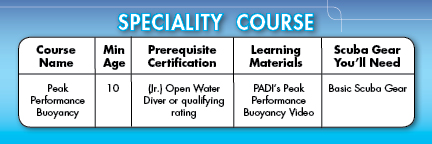Peak Performance Buoyancy
PRICE: 160 euros
2 Dives 1 Day
What is neutral buoyancy? Scuba divers like to be neutrally buoyant so they neither sink nor float. It can be a tricky thing. Divers who've mastered the highest performance levels in buoyancy stand apart. You've seen them underwater. They glide effortlessly, use less air and ascend, descend or hover, almost as if by thought. They interact gently with aquatic life and affect their surroundings minimally. The PADI Peak Performance Buoyancy course refines the basic skills you learned as a PADI Open Water Diver and elevates them to the next level.
The Fun Part
The fun part of this course is giving your dive skills a polish you may not have thought possible.
What You Learn
-
How to trim your scuba gear so you're perfectly balanced in the water
-
Nuances in determining weight so you're not too light nor too heavy by even a slight degree
-
How to streamline to save air and move smoothly through the water
-
How to hover effortlessly in both a vertical position and a horizontal position
The Scuba Gear You Use
You use all your basic scuba gear as required in your local diving environment.
The Learning Materials You Need
PADI's Peak Performance Buoyancy video on DVD provides an overview of the skills you'll practice with your instructor. It comes with an enclosed booklet that includes a buoyancy assessment questionnaire and basic weighting guidelines - useful whenever you purchase new gear or dive in a new environment.
Prerequisites

Your Peak Performance Buoyancy Adventure Dive in the PADI Advanced Open Water Diver /Adventure Diver course credits (at your instructor’s discretion) as the first dive in the PADI Peak Performance Buoyancy course
Your Next Adventure
Part of mastering buoyancy control is learning how to use your BCD & weight system effectively, plus maintain streamlining. This makes the PADI Equipment Specialist course a natural companion, because you learn more about these pieces of gear & how to make them suit your specific diving styles
